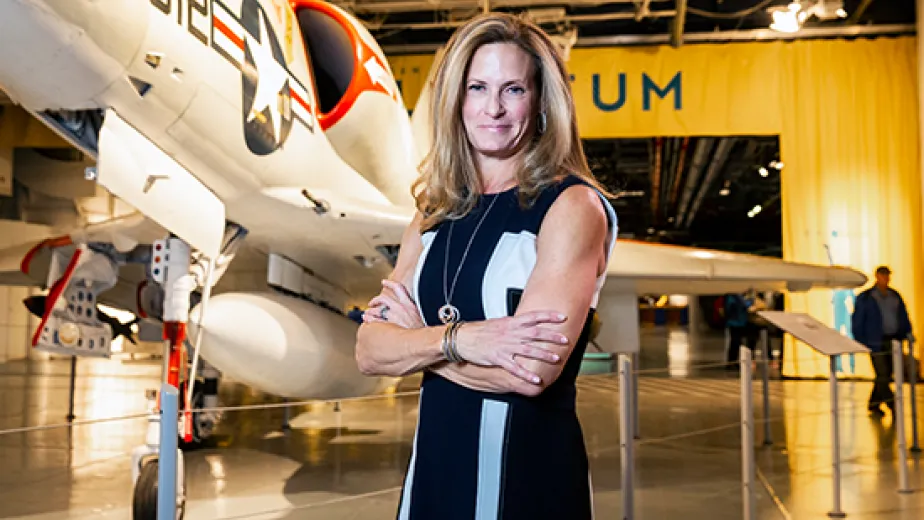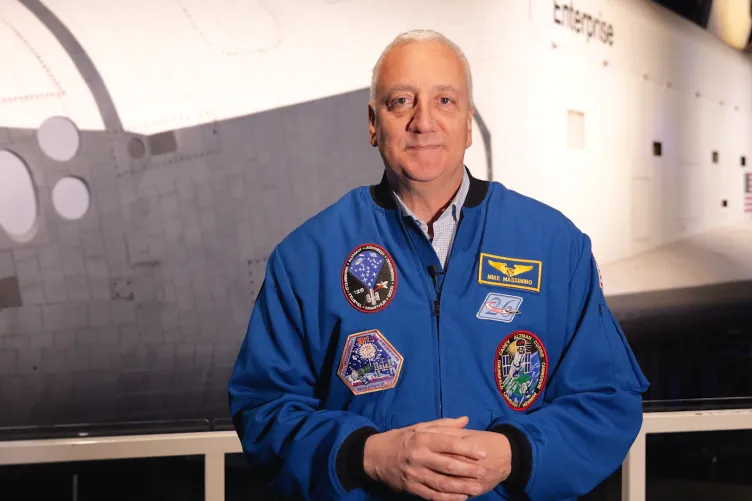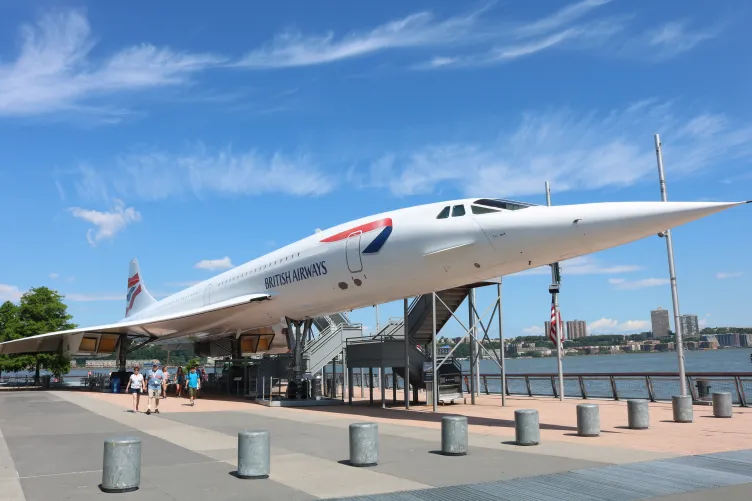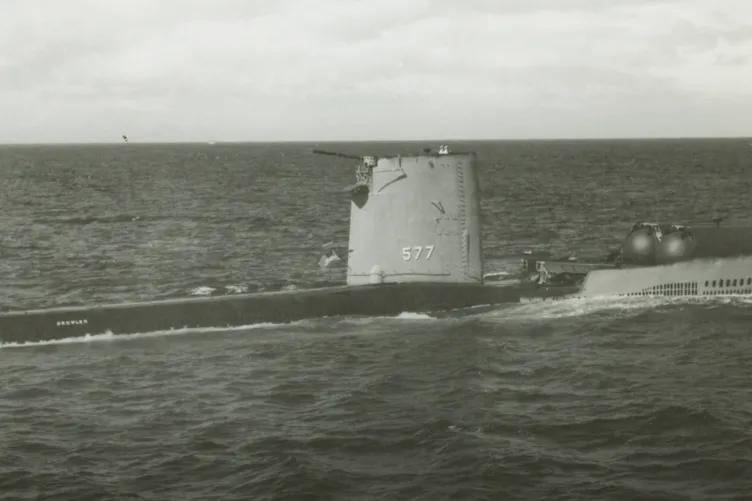
I serve as president of the Intrepid Sea, Air & Space Museum, a position I’ve held since 2011. The centerpiece of the Museum is the legendary aircraft carrier Intrepid, where 55,000 men served on board during its time of active duty and, as was reflective of the time, no women.
As the first female president of the Intrepid Museum, I embrace my obligation to use my position to ensure opportunities for the next generation. I never take that for granted, and I am grateful to the trailblazing women of all industries who came before me. Throughout Women’s History Month I will join my Intrepid Museum colleagues in spotlighting our heroes, the women who inspired us in our lives and careers.
What is your role at the Museum?
I oversee the Museum’s programs and resources for individuals with disabilities and their families, as well as the Museum’s veterans’ initiatives. My team and I develop specialized programs and work with colleagues across the Museum to ensure that our exhibits and programs are accessible and inclusive.
Who is the woman from history you most admire and why?
There are many women I admire and have learned from, but one that stands out is Sally Ride. She has been my hero since I first learned about her as a child. I admire her for being a “first,” in her case the first American woman in space, but especially for the commitment, rigor, and mindset that she brought with her. I am inspired by her curiosity and her drive to do what was right. She handled sexist questions throughout her career, especially ahead of her first space flight, played a crucial role in the Challenger and Columbia disaster investigations, and worked to give youth, especially girls, better access to STEM programming and mentorship.
How did your heroine inspire you and what are the lessons you learned that you incorporate into your job function at the Museum or elsewhere in your life?
When I was a child, Dr. Ride’s story encouraged my interest in space and science, and she provided a model as to how to confront sexism and societal expectations about the roles of girls and women. She also made it her mission to help others achieve their goals. In my work, I reflect on the importance of elevating and supporting the growth of others, both colleagues and learners. And of course, I, too, aim to inspire curiosity about space, science, history, and beyond. I also look to Dr. Ride’s work on the shuttle disaster investigations as a model of accountability and commitment to doing what is right. She knew the influence she had as America’s first woman astronaut and thoughtfully applied that in all of her efforts. I reflect on the role I can play to improve the status quo, and I strive to do so.
What is your role at the Museum?
My role at the Museum is to collaborate with amazing talents across the Exhibits, Education, and Programs divisions to develop projects that connect to our collections, engage diverse audiences, and support the mission of the Museum.
Who is the woman from history you most admire and why?
No question it is Zora Neale Hurston (1891-1960). She is best known as one of the members of the “Harlem Renaissance,” a historic literary and cultural movement in New York City’s early twentieth century whose members included Langston Hughes, Arturo Schomburg, and A. Philip Randolph.
Born in the Jim Crow South, Hurston was one of the first Black women to attend Barnard College/Columbia University and study with the “father” of American anthropology, Franz Boas. Together, they worked to bring anthropology out of its origins in colonialism and examine the concept of the anthropologist as both observer & participant. Hurston conducted most of her fieldwork in communities of the Black rural south and especially her hometown of Eatonville, Florida, one of the first all-Black incorporated communities in the U.S.
Introduced to her work when I studied anthropology at Barnard, I made Hurston the subject of my master’s research. Delving into her archives at the Schomburg and the Library of Congress and even discovering some “lost” film materials during, I came to admire her pioneering and productive work in so many fields of arts and social sciences. She documented community folklore through notetaking and audio recordings, wrote fiction and autobiography, created compositions in theater and dance, and was an innovator in the use of film in anthropological fieldwork. She made major contributions to the American arts and social sciences while tirelessly dealing with racism.
How did your heroine inspire you and what are the lessons you learned that you incorporate into your job function at the Museum or elsewhere in your life?
No one who becomes familiar with Hurston can help but be inspired by her enormous passion to explore and examine the connections between the individual and their own and the world’s history and culture. She could both critique and create, not just through academic studies but through her masterful genius for storytelling.
I found particularly inspiring her pioneering work telling stories in different media—novels, short stories, theater, art, recording, film, and even songs—in order to engage a wide range of audiences.
I feel fortunate that at the Intrepid Museum, I’m able to collaborate with talented colleagues across so many disciplines to find the multiple ways to tell history and STEAM stories in exhibits and programs and speak, as Hurston did, to many audiences.
What is your role at the Museum?
I oversee the care and preservation of our historic artifacts and facilitate donations to our collections from former crew members and their families. I work with the collections team to document, catalog and properly house items in our storage facility located on board Intrepid. We record detailed information about the Museum’s collections in our internal database, and we have recently launched our digital collections to make a selection of these records available online to the public.
Who is the woman from history you most admire and why?
I most admire Rose Valland, a French art historian and member of the French Resistance during World War II. While working at the Jeu de Paume Museum under German occupation, she hid her knowledge of the German language and secretly recorded information about over 20,000 pieces of art looted from museums and private, mostly Jewish, collections. She kept track of where artwork was transported and stored, and risked her life to inform the Resistance of planned railroad shipments so that trains carrying art would not be accidentally bombed. Those who may be familiar with the “Monuments Men” may not know that it was Valland’s records that helped recover and return the art to many of its rightful owners.
How did your heroine inspire you and what are the lessons you learned that you incorporate into your job function at the Museum or elsewhere in your life?
Through her meticulous notes, Rose Valland is credited with saving not only thousands of important works of art by famous artists, but the personal possessions and furniture from deported citizens as well. Attention to detail and record keeping are skills that I value and use every day in my work. Just as Valland sought to protect and preserve artifacts that passed through her care, I work to ensure the Intrepid’s collections will be properly documented and cared for so that future generations of visitors to the Museum can learn from our former crew members and their service.
What is your role at the Museum?
I am responsible for driving visitorship to the Museum across various types of groups, including tourist groups, school groups, scout groups, birthday parties, overnights, and more.
Who is the woman from history you most admire and why?
I admire Oprah Winfrey’s professional accomplishments and the way she became a self-made woman who inspires with grace and spirituality.
How did your heroine inspire you and what are the lessons you learned that you incorporate into your job function at the Museum or elsewhere in your life?
The way Oprah Winfrey inspires me is through the manner in which she leads. Oprah leads with a quiet authority that is inclusive, and she always approaches challenging situations with a positive example.
What is your role at the Museum?
I help facilitate donations to the Museum from people who are inspired by our mission. Our supporters consist of Museum members, passionate New Yorkers, and the former crew members who served aboard the vessels in our collection. My team and I are also tasked with supporting our community of former crew members. It’s my job to ensure they are connected to our work and supported in every way possible.
Who is the woman from history you most admire and why?
Though she’s not a famous person, my great grandmother has been a lifelong hero to me. She was born in 1908 and passed in 2008. She worked as the caretaker of a historic house outside of Philadelphia and instilled a lifelong love of history in me. She helped me understand our family’s history and how we have a duty to investigate the past to learn more about our present.
How did your heroine inspire you and what are the lessons you learned that you incorporate into your job function at the Museum or elsewhere in your life?
She inspired me to follow my passion and pursue work in history museums. If it wasn’t for her, I don’t think I would have known that it was possible to work at a museum. When I share the Intrepid’s story, I try to keep the values she taught me in mind.
What is your role at the Museum?
I am the Manager of Teen Leadership Programs.
Who is the woman from history you most admire and why?
I would love to share that my mother is the one I admire most. I would say the second runner-up is Toni Morrison. As a young girl, I was shy, quiet, and inside my own head. Because of this, I was an avid reader and writer. I wrote poems, short stories, teen novels (to the best of my ability), and songs. As I grew into a teenager, I started reading books by Toni Morrison. My goodness—she blew my mind! Her books The Bluest Eye, Beloved, Song of Solomon, are such great works of fiction, history and poetry.
The way Toni Morrison can transform the words on the page, with her simple rhythms and word choice, invited you into the story. You lived and breathed with the characters, and became so invested and touched by them that it was hard sometimes to remove oneself from the pages. The characters, especially the Black characters, reminded me so much of the stories my mother and her family experienced in America's deep South. These stories and experiences whispered and shouted, they loved, lived and died. And they were real to me. Toni Morrison makes them real. I admire Toni Morrison’s life as a hard-working Black woman in America, a mother, and a writer. She was so long overlooked, especially by white America for her talent, her worth, and her significance in the movement of Black people. I admire her grit, her confident presence, the lilt in her voice when I heard her speak in interviews and TV documentaries. I admire her use of the American language to tell a story, thorough and true.
How did your heroine inspire you and what are the lessons you learned that you incorporate into your job function at the Museum or elsewhere in your life?
Although I am not a writer by profession and my degree is in geology and geomorphology, words and storytelling are still with me. As a Museum educator, I learned from colleagues about the history of Intrepid and learned how to tell a story. I have absorbed the way Toni Morrison tells a story to evoke, enrich, educate and sustain us. Through my work with girls, women and families in STEM, I have had to fine tune my writing, presentation and communication skills. As an adult, I fully understand the power that each can have. I have influence, and I am able to place color and emphasis in the words I say and the words I write. I now understand the weight of words, and that through them truths can be brought to light, examples can be given, experiences can be shared and whole worlds can be discovered.
What is your role at the Museum?
As a Senior Museum Educator, I work mostly with programming for K-12 students and teachers.
Who is the woman from history you most admire and why?
There are so many! Maria Mitchell (America’s first female astronomer), Marie Curie, Katherine Johnson…I’m really inspired by women who were doing science in a time when the world told them they weren’t supposed to, or they were expected to be no more than wives and mothers.
How did your heroine inspire you and what are the lessons you learned that you incorporate into your job function at the Museum or elsewhere in your life?
The women from history that I admire definitely inspired me to keep going in my science studies (I was one of the few women in many of my college astronomy classes). I often think about Maria Mitchell who was an educator in addition to being an astronomer and advocated for girls to receive math and science education. But as far as what I incorporate into my job function or life, I’m far more influenced by women who won’t necessarily be remembered by history: my mom who was an immigrant and came to this country at 18 years old made me brave enough to come to NJ/NY for grad school. My 10th grade English teacher, Janet Hall, who simply loved what she did so much so that I actually wanted to read Tess of the d’Urbervilles, making me realize how contagious enthusiasm really is. And Dr. Vicki Sarajedini at the University of Florida, a brilliant astronomy professor who also schlepped an inflatable planetarium to local elementary schools, making me realize that I could merge an interest in intense science with a desire to share it with others. These women were far more real to me and influential in my life than the great women in the history books.
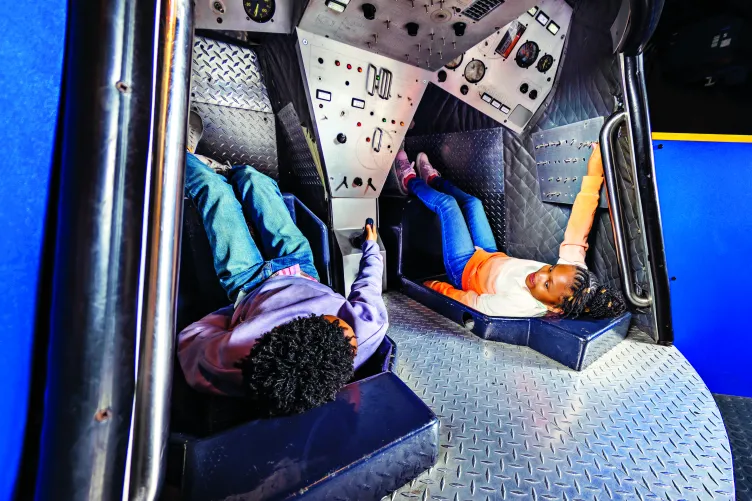
Want to visit the museum? We would love to have you! Find out all about our offerings here and plan your trip today.
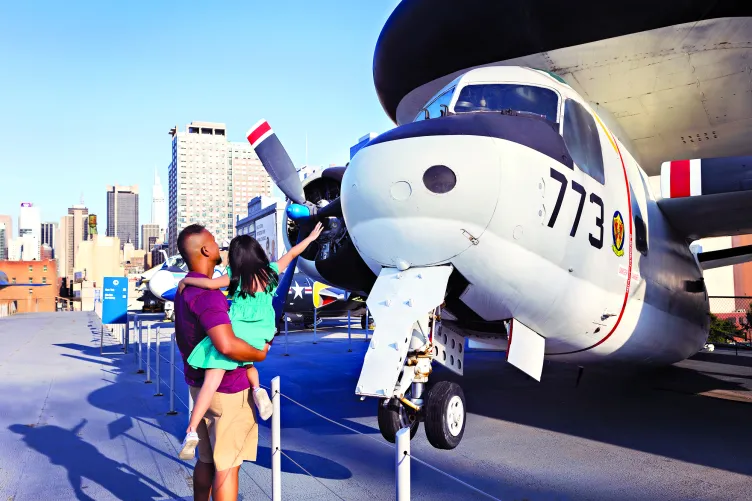
If you join our membership program you can visit the museum any time! Plus enjoy many membership perks at a discounted rate.


